
The Trans-Siberian Railway (Transsib, Транссиб connects European Russia to the Russian Far East. Spanning a length of over 9,289 kilometers, it is the longest railway line in the world. It runs from the city of Moscow in the west to the city of Vladivostok in the east.
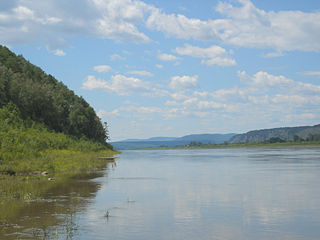
The Amur, or Heilong Jiang, is the world's tenth longest river, forming the border between the Russian Far East and Northeastern China. The Amur proper is 2,824 kilometres (1,755 mi) long, and has a drainage basin of 1,855,000 km2 (716,000 sq mi). Including its source river Argun, it is 4,444 km (2,761 mi) long. The largest fish species in the Amur is the kaluga, attaining a length as great as 5.6 metres (18 ft). The river basin is home to a variety of large predatory fish such as northern snakehead, Amur pike, taimen, Amur catfish, predatory carp and yellowcheek, as well as the northernmost populations of the Amur softshell turtle and Indian lotus.

Lieutenant Colonel Robert Peter Fleming was a British adventurer, journalist, soldier and travel writer. He was the elder brother of Ian Fleming, creator of James Bond.

Heilongjiang, formerly romanized as Heilungkiang; Wade-Giles: Heilungchiang, is a province in northeast China. The standard one-character abbreviation for the province is 黑. It is the northernmost and easternmost province of the country and contains China's northernmost point and easternmost point.

The Nanai people are a Tungusic people of East Asia who have traditionally lived along Heilongjiang (Amur), Songhuajiang (Sunggari) and Wusuli River on the Middle Amur Basin. The ancestors of the Nanai were the Jurchens of northernmost Manchuria.

The Treaty of Aigun was an 1858 treaty between the Russian Empire and the Qing dynasty that established much of the modern border between the Russian Far East and China by ceding much of Manchuria, now known as Northeast China. Negotiations began after China was threatened with war on a second front by Governor-General of the Far East Nikolay Muraviev when China was suppressing the Taiping Rebellion. It reversed the Treaty of Nerchinsk (1689) by transferring the land between the Stanovoy Range and the Amur River from the Qing Dynasty to the Russian Empire. Russia received over 600,000 square kilometers (231,660 sq mi) of Outer Manchuria.

The Treaty of Nerchinsk of 1689 was the first treaty between the Tsardom of Russia and the Qing dynasty of China. The Russians gave up the area north of the Amur River as far as the Stanovoy Range and kept the area between the Argun River and Lake Baikal. This border along the Argun River and Stanovoy Range lasted until the Amur Annexation via the Treaty of Aigun in 1858 and the Convention of Peking in 1860. It opened markets for Russian goods in China, and gave Russians access to Chinese supplies and luxuries.

Northeast Asia or Northeastern Asia is a geographical subregion of Asia; its northeastern landmass and islands are bounded by the Pacific Ocean.
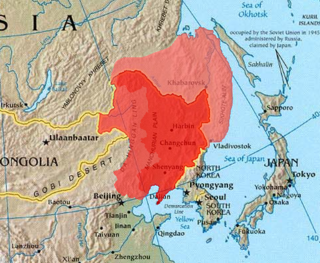
Outer Manchuria, or Outer Northeast China, refers to a territory in Northeast Asia that is now part of Russia but used to belong to a series of dynasties based in China, including the Tang, Liao, Jin, Eastern Xia, Yuan, Northern Yuan, Ming, Later Jin, and Qing dynasties. The Russian Empire annexed this territory through a series of unequal treaties forced upon Qing China, most notably the Treaty of Aigun in 1858 and the Treaty of Peking in 1860. It is a part of the larger region of Manchuria, with the term "Outer Manchuria" only arising because of the Russian annexation.

The Argun or Ergune is a 1,620-kilometre (1,010 mi) long river that forms part of the eastern China–Russia border, together with the Amur. Its upper reaches are known as Hailar River in China. The Argun marks the border between Russia and China for about 944 kilometres (587 mi), until it meets the Amur.

The genre of travel literature encompasses outdoor literature, guide books, nature writing, and travel memoirs.

Nikolai Spathari, also known as Nicolae Milescu and Nicolae Milescu Spătaru, or Spătarul Milescu-Cârnu, was a Moldavian-born writer, diplomat and traveler, who lived and worked in the Tsardom of Russia. He spoke nine languages: Romanian, Russian, Latin, both Attic and Modern Greek, French, German, Turkish and Swedish. One of his grandsons was the Spătar (Chancellor) Yuri Stefanovich, who came to Russia in 1711 with Dimitrie Cantemir.

Colin Gerald Dryden Thubron, FRAS is a British travel writer and novelist. In 2008, The Times ranked him among the 50 greatest postwar British writers. He is a contributor to The New York Review of Books, The Times, The Times Literary Supplement and The New York Times. His books have been translated into more than twenty languages. Thubron was appointed a CBE in the 2007 New Year Honours. He is a Fellow and, between 2009 and 2017, was President of the Royal Society of Literature.
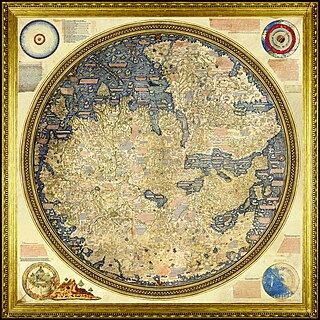
This is a chronology of the early European exploration of Asia.
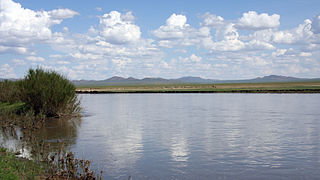
Kherlen River is a 1,254 km river in Mongolia and China.
The Thomas Cook Travel Book Award originated as an initiative of Thomas Cook AG in 1980, with the aim of encouraging and rewarding the art of literary travel writing. The awards stopped in 2005. As of 2008, the only other travel book award in Britain is the Dolman Best Travel Book Award, begun in 2006.

The Siberian Route, also known as the Moscow Highway and Great Highway, was a historic route that connected European Russia to Siberia and China.
The Edward Stanford Travel Writing Awards celebrate the best travel writing and travel writers in the world. The awards include the Stanford Dolman Travel Book of the Year and the Edward Stanford Award for Outstanding Contribution to Travel Writing.
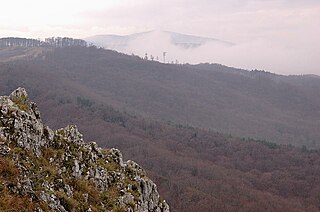
Zeya Nature Reserve is a Russian 'zapovednik' located over the mountainous headwaters of the Zeya River, on the eastern end of the Tukuringra Range, where it joins the Dzhagdy, in the Amur Region of the Russian Far East. It was created in part to serve as a "reference plot" for the study of the ecological impact of the Zeya Dam and the Zeya Reservoir which were built in the 1960s and 1970s. The ground cover in the reserve is primarily taiga, of mostly larch and Mongolian oak. The reserve is situated 13 km north of the city of Zeya, in the Zeysky District of Amur Oblast.

















